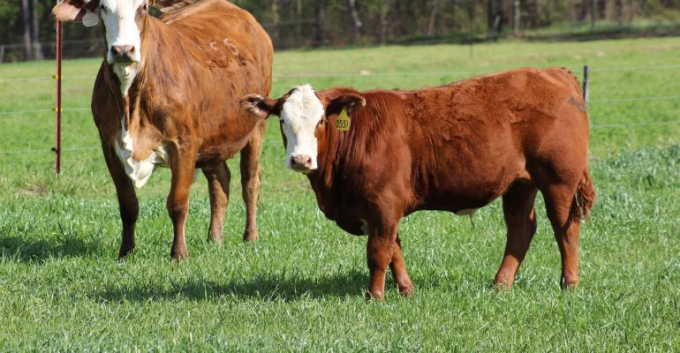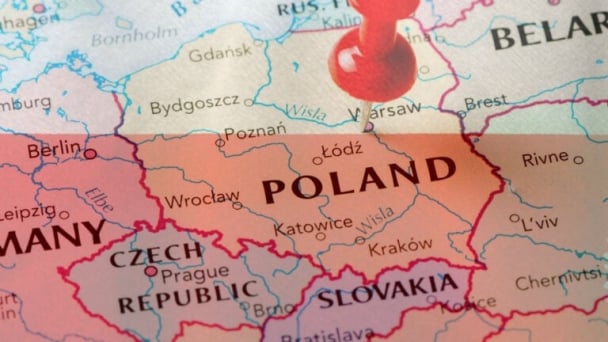June 21, 2025 | 02:33 GMT +7
June 21, 2025 | 02:33 GMT +7
Hotline: 0913.378.918
June 21, 2025 | 02:33 GMT +7
Hotline: 0913.378.918

A cow-calf pair on moderate-stocked Nelson ryegrass, developed by Lloyd Nelson's breeding program at Overton. Photo: Getty
Cow-calf and stocker operators find themselves in yet another period of high fertilizer and fuel prices and must make necessary management decisions concerning production targets, according to two longtime Texas A&M AgriLife Research scientists at the Texas A&M AgriLife Research and Extension Center in Overton.
Monte Rouquette, Ph.D., forage physiologist, and Gerald Smith, Ph.D., clover breeder, both in the Texas A&M College of Agriculture and Life Sciences Department of Soil and Crop Sciences, say the rules for managing pastures and livestock systems are changing with increasing fertilizer and fuel costs.
"The energy crisis experienced in years past was just an appetizer compared to what cattle operators are experiencing now in forage-animal production," Rouquette says. "They have experienced increased prices in fuel, fertilizers and feed ingredients, and now the costs of 'doing business' have caused many to rethink their operating strategies."
Stocking management decisions
Setting production targets, managing to manipulate forage utilization systems to enhance economic returns, and sustaining the soil-plant resources are still the name of the game, he says. But the process may be different under high input prices.
Stocking strategies and nutrient cycling have inseparable relationships, Rouquette says. There is an increased dependency on recycled nutrients in grazed pastures for forage production during unstable and increasing fertilizer, fuel and feed grain costs.
"Management strategies are personal and need to be 'zip code-specific' in the pasture assessments of forage utilization, hay, overseeding, fertilization, that must be made," he says. "Concurrent, critical decisions must be made for the class of beef cattle used, their efficiency of production, and returns based on pasture occupancy and weight of the animals."
Cow-calf and/or stocker operations on pastures require ongoing management decisions to adjust for seasonal and total forage production availability, animal performance expectations, wintering costs and other operating expenses, Rouquette says. In general, rainfall and temperature fluctuations and soil nutrient status are the biggest factors controlling forage production.
"Your stocking rate adjustments dictate requirements for fertilizer, hay and/or supplemental feed to meet animal performance expectations," he says. "For cow-calf producers, wintering costs associated with hay and supplements needed to maintain cow condition for calving and rebreeding are responsible for a substantial part of the 12-month cow costs.
"Thus, fertilizer management during the summer months, hay production or purchase, and inclusion of winter annual pastures require primary consideration during times of escalating input prices."
Fertilizing for feeding expectations
Rouquette says in response to increased fertilizer prices, producers may choose an array of options. However, these strategies will likely include one of the following: eliminate all fertilizer, reduce fertilizer to minimum applications, or continue with moderate fertilization applications.
Smith adds that selecting clovers to eliminate the use of nitrogen fertilization requires soil-site specific locations regarding drainage, etc. In addition, a soil test in advance of planting offset risks associated with low levels of phosphorus and soil pH, for example.
The economic dilemma for producers is that there is no transition period to adapt to the new pasture-beef production cost paradigm, he says. With no likely price reductions in fuel, fertilizer and feed grains in either the short-term or long-term future, every cash input must be evaluated and scrutinized for potential returns.
Grass production is nitrogen dependent. The basic pasture forages in Texas, as well as in most grazing lands of the world, are warm-season perennial grasses. These forages include Bermuda, Bahia and Dallis grasses and numerous other introduced and native species.
In many areas of Texas, nitrogen-containing fertilizers have been a regular part of hay and pasture production for livestock. The immediate and perhaps long-term extended changes in fertilization of forage for pasture and/or hay will depend on numerous factors. These include the price of cattle; forage requirements for soil nitrogen-phosphorous-potassium and time to meet pasture and/or hay needs; sustainable economic stocking rate with moderate, minimum or no fertilization; and alternative land use without livestock.
Find the right path
As forage-cattle producers move into the next paradigm of input costs, the secrets for success are closely tied to "using forages that produce and animals that perform," Rouquette says. "This mandates that every aspect of the forage-cattle operation must be critically evaluated."
For many operators who choose to eliminate most, if not all, fertilizers, the long-term experimentation at Texas A&M AgriLife Research-Overton suggests nutrient cycling under grazing is a valuable asset for forage production in pastures. And some grass species composition changes will occur once nitrogen fertilizer is removed for prolonged durations.
Rouquette says some of the checklist management strategies that counter increased fertilizer, fuel and feed prices include the following:
Create a pasture management plan that is firm but flexible.
Implement a fertilization strategy via a soils test and need.
In many situations, the most cost-effective fertilizer strategy is to apply one or two nitrogen applications at 50 to 60 pounds per acre per application. However, soil levels of potassium and pH are linked to the sustainability of hybrid Bermuda grasses.
Add legumes to the pasture system after conducting soil test and assessing soil pH.
Use broiler litter as a nutrient source.
Increase efficiency of forage utilization with timely stocking and/or electric fencing for additional pastures.
Make hay from pastures at any time practical, and eliminate exclusive hay meadows.
Purchase hay based on nutrient analyses and weight.
Make strategic, timely herbicide applications.
Maintain accurate, up-to-date cattle records for culling options.
Reduce stocking rate.
Enhance weaning percent, weaning weight and/or weight at the time of sales.
Alter weaning schedule; retain ownership options.
Critically assess supplementation strategies, product cost and supplement based on extra gain conversion.
Market cattle proactively.
For more details, view Rouquette and Smith's "Long-term cow-calf performance on over-seeded bermudagrass pastures at different stocking and fertility regimens: 2022 Fertilizer prices and cost of gain."
Adjusting to High Fuel and Fertilizer Prices includes documents on how to adjust cattle operations according to high fuel and fertilizer prices in past energy crisis.
(Beef)

(VAN) Poultry production in Poland, which has only started recovering from devastating bird flu outbreaks earlier this year, has been hit by a series of outbreaks of Newcastle disease, with the veterinary situation deteriorating rapidly.

(VAN) Extensive licensing requirements raise concerns about intellectual property theft.

(VAN) As of Friday, a salmonella outbreak linked to a California egg producer had sickened at least 79 people. Of the infected people, 21 hospitalizations were reported, U.S. health officials said.

(VAN) With the war ongoing, many Ukrainian farmers and rural farming families face limited access to their land due to mines and lack the financial resources to purchase needed agricultural inputs.

(VAN) Vikas Rambal has quietly built a $5 billion business empire in manufacturing, property and solar, and catapulted onto the Rich List.

(VAN) Available cropland now at less than five percent, according to latest geospatial assessment from FAO and UNOSAT.

(VAN) Alt Carbon has raised $12 million in a seed round as it plans to scale its carbon dioxide removal work in the South Asian nation.